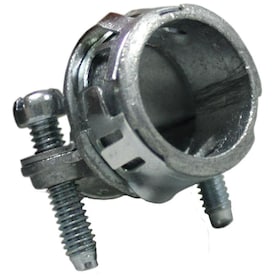...Thanks for any wisdom!
In my case, those thanks are in all likelihood misdirected...But since this is about a twist-on/off device, I feel
totally qualified to answer your query.

Seriously, I just checked my breaker box (which is on an exterior wall
outside my house), and reminded myself that I too (rightly or wrongly) used the same kind of cable-clamp (installed from the
outside of the breaker box; tightened with its circular nut from inside the breaker box) when I installed a new 240-volt circuit.
(I assume that the idea of a cable clamp is to protect the wire from the sharp edges of the punched-out circular hole [into the metal breaker box], possible strain-relief [from what?], and/or to shrink the remaining opening once the wire is through it [to inhibit insect/rodent passage]?)
In my case, I have wood siding surrounding my breaker box. So I choose to wait for a siding replacement project before I installed the new circuit. Drywall repair takes work, for sure, but is normally far easier/cheaper to deal with than exterior wood siding.
(Can I ask, how did you expect to fish the wire through the wall into your breaker box without removing at least some wall covering? Never mind.)
I assume that your breaker panel is in the garage? Or maybe (in a closet or elsewhere) inside the house? Is the wall finished (surfaced and painted) or unfinished? If finished, as you know a discrete hole can be made, then repaired so that it can’t be detected. Not too expensive—just takes some practice. (Maybe you already know how?)
So if you are to use a cable clamp, arguably the
best solution(?) is just to carefully make a hole in the drywall, then patch/finish it as necessary.
But if you have to avoid making a hole in the drywall, here is another idea I got from looking at my breaker box just now. Not sure if it (a) possible and (b) would pass (official) muster.
First, check to see if in the bottom and/or top of your breaker box there are different sized punch-out holes (placed there by the BB manufacturer to allow the addition of new wire circuits). If so, hardware stores should offer different sized metal cable clamps and push-in insert/plug covers to fit these various standard-sized holes.


- If you do find a large knockout hole in the breaker box, purchase a push-in metal insert/plug for that size of large hole.
- Drill the large insert/plug out for a smaller cable clamp (smallest clamp that will accept your [#6?] wire bundle).
- Install the small clamp into the large insert through the bottom of the insert, with the circular nut tightening from the top side.
- Run your wire as planned through the wall, into the breaker box through the large hole, and through the clamp-insert assembly.
- Push clamp-insert assembly into the large hole from the inside of the breaker box.
Does that make sense? (See diagram, below.) Might be considered “cheating” by regulators(?), but could that solve your problem and alleviated the need to remove drywall?
But as
Feathermerchan suggests (saw his comment after I began this one), a simple plastic press-in bushing, or a plastic insert/plug drilled to just accept the wire, would be simpler and remove danger to the wire from the sharp hole edges. (No strain relief, though, if that is a thing, and would not stop gnawing rodents.) I am unsure whether cable clamps are required by code. If not, sounds like the bushing suggestion is the simplest solution.








